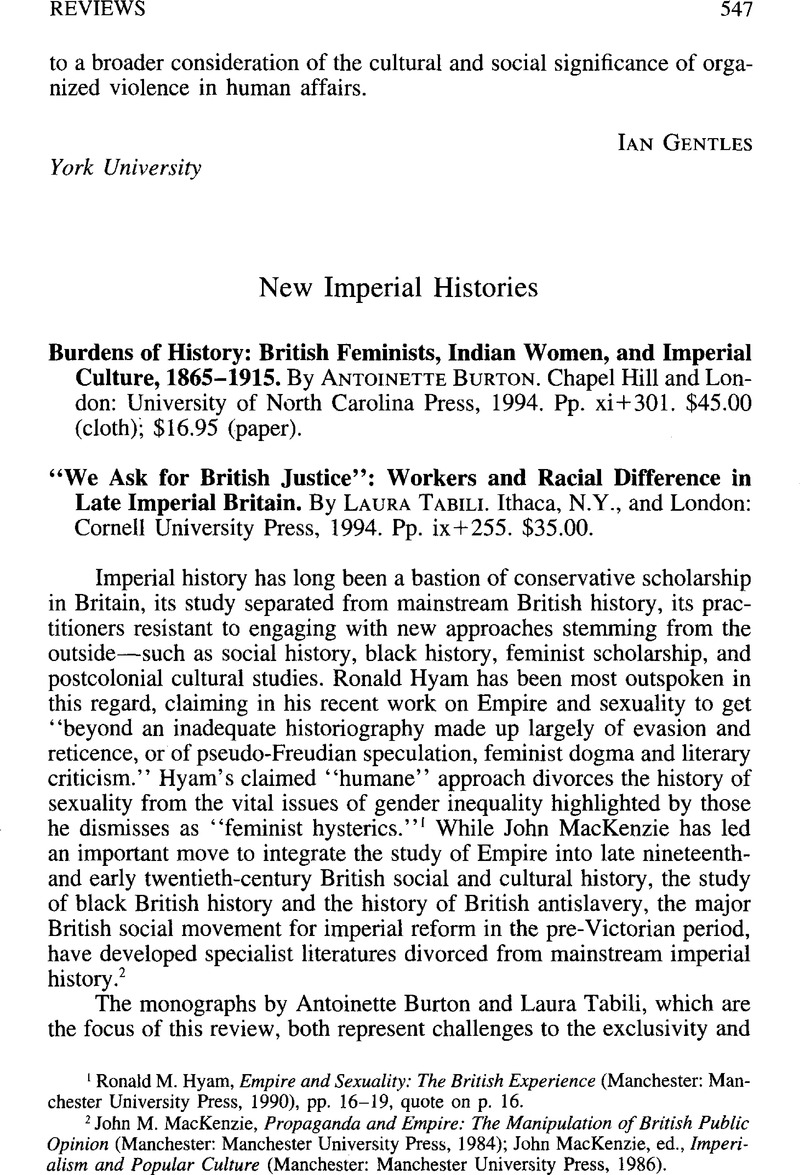Article contents
New Imperial Histories - Burdens of History: British Feminists, Indian Women, and Imperial Culture, 1865–1915. By Antoinette Burton. Chapel Hill and London: University of North Carolina Press, 1994. Pp. xi+301. $45.00 (cloth); $16.95 (paper). - “We Ask for British Justice”: Workers and Racial Difference in Late Imperial Britain. By Laura Tabili. Ithaca, N.Y., and London: Cornell University Press, 1994. Pp. ix+255. $35.00.
Published online by Cambridge University Press: 10 January 2014
Abstract

- Type
- Reviews
- Information
- Copyright
- Copyright © North American Conference of British Studies 1996
References
1 Hyam, Ronald M., Empire and Sexuality: The British Experience (Manchester: Manchester University Press, 1990), pp. 16–19, quote on p. 16Google Scholar.
2 MacKenzie, John M., Propaganda and Empire: The Manipulation of British Public Opinion (Manchester: Manchester University Press, 1984)Google Scholar; MacKenzie, John, ed., Imperialism and Popular Culture (Manchester: Manchester University Press, 1986)Google Scholar.
3 Increasing willingness to tackle these issues in Britain is reflected by the focus on ethnicity and race at the fourth annual conference of the Women's History Network, University of Manchester, September 16–17, 1995. For a pioneering work in this area, see Ware, Vron, Beyond the Pale: White Women, Racism and History (London: Verso, 1992)Google Scholar; see also Midgley, Clare, “Ethnicity, Race and Empire,” in Women's History: Britain, 1850–1945, ed. Purvis, June (London: University College London Press, 1995)Google Scholar.
4 Amos, Valerie and Parmar, Pratibha, “Challenging Imperial Feminism,” Feminist Review, no. 17 (July 1984), pp. 3–19Google Scholar.
5 See Ware.
6 For examples of recent work, see “Feminism, Imperialism and Race: A Dialogue between India and Britain,” a special issue of the Women's History Review, vol. 3, no. 4 (1994)Google Scholar.
7 Midgley, Clare, Women Against Slavery: The British Campaigns, 1780–1870 (London: Routledge, 1992)Google Scholar.
8 See, e.g., Chaudhuri, N. and Strobel, M., eds., Western Women and Imperialism: Complicity and Resistance (Bloomington: Indiana University Press, 1992)Google Scholar. For a thoughtful consideration of some of the problems involved in writing about white women and imperialism, see Haggis, Jane, “Gendering Colonialism or Colonising Gender? Recent Women's Studies Approaches to White Women and the History of British Colonialism,” Women's Studies International Forum 13 (1990): 105–15CrossRefGoogle Scholar.
9 Hall, Catherine, White, Male and Middle Class: Explorations in Feminism and History (Cambridge: Polity Press, 1992), pp. 205–95Google Scholar; Dawson, Graham, Soldier Heroes: British Adventure, Empire and the Imagining of Masculinities (London: Routledge, 1994)Google Scholar; Sinha, Mrinalini, Colonial Masculinity: The “Manly Englishman” and the “Effeminate Bengali” in the Late Nineteenth Century (Manchester: Manchester University Press, 1995)Google Scholar. See also Foley, Tadgh, Pilkington, Lionel, Ryder, Sean, and Tilley, Elizabeth, Gender and Colonialism (Galway: Galway University Press, 1995)Google Scholar.
10 Bland, Lucy, Banishing the Beast: English Feminism and Sexual Morality, 1885–1914 (London: Penguin, 1995), esp. chap. 6Google Scholar.
11 Ramdin, Ron, The Making of the Black Working Class in Britain (Aldershot: Gower, 1987), p. 507Google Scholar. Ramdin, in a chronologically wide-ranging and thorough overview, stresses the importance of autonomous black organization. Surprisingly, Tabili does not engage with Ramdin's work beyond this single criticism.
12 See, e.g., Sinclair, N. M. C., The Tiger Bay Story (Cardiff: Butetown History and Arts Project, 1993)Google Scholar; van Helmond, M. and Palmer, D., Staying Power: Black Presence in Liverpool (Liverpool: National Museums and Galleries on Merseyside, 1991)Google Scholar.
- 1
- Cited by




